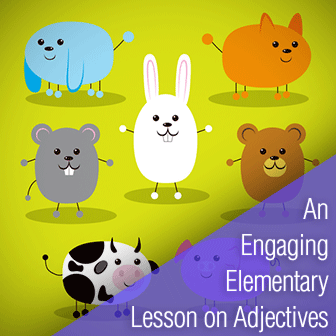What Do You See? 8 Steps to Teaching Basic Vocabulary


Still, you want them to have fun and make a personal connection with the material you teach even when you are teaching grammar. Here is an activity you can do with your elementary level ESL students that will get them thinking creatively and using adjectives appropriately, and they will have fun, too!

Start by asking your class to describe the weather in winter. What clothes do people typically wear in the winter? Why do they wear these clothes? If your students are willing, allow some of them to share a personal story of when they were outside in winter weather and how it felt. If they do not have a story to share, you might want to share a story of your own, perhaps the first time you saw snow or an experience sledding or skiing.
After your discussion, read your class The Mitten by Jan Brett. This charming story tells the tale of how a mitten left behind became a cozy place for several animals to hide from the winter cold.
Ask your students to retell the story of the mitten as you show them the pictures. As they retell the story, ask what it might have felt like when each animal crowded into the mitten. As you do, your students will naturally offer descriptive words for each of the animals. You should point out that words which describe things or people are adjectives.
Close the book and ask your students which animals crowded into the mitten. Write each animal on the board as they say it. Then, taking one animal at a time, ask what words they can use to describe that animal. You should allow your students to use their dictionaries as they offer adjectives that can be used to describe each animal. Make a list of adjectives under each animal on the board. You will want to include words like fuzzy, soft, prickly, sharp, warm, little, big, lumpy and others on your list.
You can review some of these adjectives by playing a game with your students. On her website, Jan Brett has pictures of the animals in her book, which are designed to be used as masks. Print enough of these so each student has a mask to use during the game. Allow students to cut out their masks and then attach a tongue depressor to the bottom. Now ask your students questions using the adjectives you listed on the board. “Who is fuzzy?” If their animal is fuzzy, the student should stand. Repeat with a different adjective. Your students should notice that some adjectives can be used to describe more than one of the animals from the book.
After playing the game, ask your students to think about their favorite animal. This can be an animal from the story one that was not in the book. Ask your students, “What words on the board can be used to describe that animal?” Put your students into groups of three and ask them to describe their animal to the group. Encourage students to think of other adjectives that can describe their animals and their friends’ animals. Each student should make a list of these adjectives that describe the animal he chose.
Now that your students have thought about their animals and made a list of the adjectives to describe it, have your students write a paragraph describing the animal they chose. In their paragraph, they should use several adjectives to describe their animal.
Once each student is finished with their paragraph, give them time with your classroom computer or take them to the computer lab to type out their paragraphs. Using the paint program on the computer, they can draw a picture of their animal. Have students spell check their paragraphs and print them out. You can then compile the paragraphs and pictures into a classroom book. Make this book available to your students during independent reading time.
Not only that, they will learn how to use adjectives to describe these winter animals and their own favorites, too. The end result will be a book that your class will treasure for the entire year.